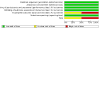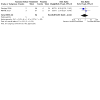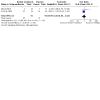Herbal medicinal products or preparations for neuropathic pain
- PMID: 30938843
- PMCID: PMC6445324
- DOI: 10.1002/14651858.CD010528.pub4
Herbal medicinal products or preparations for neuropathic pain
Abstract
Background: Neuropathic pain is a consequence of damage to the central nervous system (CNS), for example, cerebrovascular accident, multiple sclerosis or spinal cord injury, or peripheral nervous system (PNS), for example, painful diabetic neuropathy (PDN), postherpetic neuralgia (PHN), or surgery. Evidence suggests that people suffering from neuropathic pain are likely to seek alternative modes of pain relief such as herbal medicinal products due to adverse events brought about by current pharmacological agents used to treat neuropathic pain. This review includes studies in which participants were treated with herbal medicinal products (topically or ingested) who had experienced neuropathic pain for at least three months.
Objectives: To assess the analgesic efficacy and effectiveness of herbal medicinal products or preparations for neuropathic pain, and the adverse events associated with their use.
Search methods: We searched CENTRAL and the Cochrane Database of Systematic Reviews, MEDLINE, Embase, CINAHL and AMED to March 2018. We identified additional studies from the reference lists of the retrieved papers. We also searched trials registries for ongoing trials and we contacted experts in the field for relevant data in terms of published, unpublished or ongoing studies.
Selection criteria: We included randomised controlled trials (including cross-over designs) of double-blind design, assessing efficacy of herbal treatments for neuropathic pain compared to placebo, no intervention or any other active comparator. Participants were 18 years and above and had been suffering from one or more neuropathic pain conditions, for three months or more.We applied no restrictions to language or gender. We excluded studies monitoring effects of isolated, single chemicals derived from the plant or synthetic chemicals based on constituents of the plant, if they were not administered at a concentration naturally present within the plant.We excluded studies monitoring the effects of traditional Asian medicine and Cannabinoids as well as studies looking at headache or migraine as these treatments and conditions are addressed in distinct reviews.
Data collection and analysis: We used standard methodological procedures expected by Cochrane. Two review authors independently considered trials for inclusion, assessed risk of bias, and extracted data. We calculated the risk ratio (RR) and number needed to treat for an additional beneficial outcome (NNTB). The primary outcomes were participant-reported pain relief of 30%, or 50%, or greater, and participant-reported global impression of clinical change (PGIC). We also collected information on adverse events. We assessed evidence using GRADE and created a 'Summary of findings' table.
Main results: We included two studies (128 participants). Both diabetic neuropathy and non-diabetic neuropathic pain conditions were investigated across these two studies.Two herbal medicinal products, namely nutmeg (applied topically as a 125 mL spray for four weeks, containing mace oil 2%, nutmeg oil 14%, methyl salicylate 6%, menthol 6%, coconut oil and alcohol) and St John's wort (taken in capsule form containing 900 μg total hypericin each, taken three times daily, giving a total concentration of 2700 mg for five weeks). Both studies allowed the use of concurrent analgesia.Both reported at least one pain-related outcome but we could not carry out meta-analysis of effectiveness due to heterogeneity between the primary outcomes and could not draw any conclusions of effect. Other outcomes included PGIC, adverse events and withdrawals. There were no data for participant-reported pain relief of 50% or greater or PGIC (moderate and substantial) outcomes.When looking at participant-reported pain relief of 30% or greater over baseline, we observed no evidence of a difference (P = 0.64) in response to nutmeg versus placebo (RR 1.12, 95% confidence interval (CI) 0.69 to 1.85; 48.6% vs 43.2%). We downgraded the evidence for this outcome to very low quality.We observed no change between placebo and nutmeg treatment when looking at secondary pain outcomes. Visual analogue scale (VAS) scores for pain reduction (0 to 100, where 0 = no pain reduction), were 44 for both nutmeg and placebo with standard deviations of 21.5 and 26.5 respectively. There was no evidence of a difference (P = 0.09 to 0.33) in total pain score in response to St John's wort compared to placebo, as there was only a reduction of 1 point when looking at median differences in change from baseline on a 0 to 10-point numeric rating scale.There was a total of five withdrawals out of 91 participants (5%) in the treatment groups compared to six of 91 (6.5%) in the placebo groups, whilst adverse events were the same for both the treatment and placebo groups.We judged neither study as having a low risk of bias. We attributed risk of bias to small study size and incomplete outcome data leading to attrition bias. We downgraded the evidence to very low quality for all primary and secondary outcomes reported in this review. We downgraded the quality of the evidence twice due to very serious limitations in study quality (due to small study size and attrition bias) and downgraded a further level due to indirectness as the included studies only measured outcomes at short-term time points. The results from this review should be treated with scepticism as we have very little confidence in the effect estimate.
Authors' conclusions: There was insufficient evidence to determine whether nutmeg or St John's wort has any meaningful efficacy in neuropathic pain conditions.The quality of the current evidence raises serious uncertainties about the estimates of effect observed, therefore, we have very little confidence in the effect estimate; the true effect is likely to be substantially different from the estimate of effect.
Conflict of interest statement
AB: none known
CB: none known
DH: none known
CG: none known
MHF: none known
PB is a retired consultant in pain medicine who has treated patients with neuropathic pain in the past. She received funding from Grunenthal pharmaceutical company in 2017.
SMcD: none known
Figures





Update of
- doi: 10.1002/14651858.CD010528.pub3
References
References to studies included in this review
Motilal 2013 {published data only}
-
- Motilal S, Maharaj R. Nutmeg extracts for painful diabetic neuropathy: a randomized, double blind, controlled study. Journal of Alternative and Complementary Medicine 2013;19(4):337-2. - PubMed
Sindrup 2000 {published data only}
-
- Sindrup S, Masden C, Bach F, Gram L, Jensen T. St John's wort has no effect on pain in polyneuropathy. Pain 2000;91:361-5. - PubMed
References to studies excluded from this review
Abrams 2007 {published data only}
-
- Abrams D, Jay C, Shade S, Vizso H, Reda H, Press S. Cannabis in painful HIV associated sensory neuropathy. Neurology 2007;68:515-1. - PubMed
Barton 2011 {published data only}
Cruccu 2018 {published data only}
Hambardzumyan 2017 {published data only}
-
- Hambardzumyan H, Manvelyan H. The treatment of painful diabetic neuropathy with capsaicin gel. Journal of the Neurological Sciences 2017;381 (supplement):976.
ISRCTN29199098 {unpublished data only}29199098
-
- ISRCTN29199098. Efficacy of a topical cannabinoid preparation in decreasing symptoms of rheumatoid arthritis. www.isrctn.com/ISRCTN29199098 (accessed 18 December 2016).
Khodari 2017 {published data only}
-
- Khodari SN, Noordin MI, Chan L, Chik Z. In vitro and in vivo evaluation of new topical anaesthetic cream formulated with palm oil base. Current Drug Delivery 2017;14(5):690-5. - PubMed
Mankowski 2017 {published data only}
Moon 2017 {published data only}
-
- Moon JY, Lee PB, Kim YC, Lee SC, Nahm FS, Choi E. Efficacy and safety of 0.625% and 1.25% capsaicin patch in peripheral neuropathic pain: multi-center, randomized, and semi-double blind controlled study. Pain Physician 2017;20(2):27-35. - PubMed
Paice 2000 {published data only}
-
- Paice J, Ferrans C, Lashley F, Shott S, Vizgirda V, Pitrak D. Topical capsaicin in the management of HIV-associated peripheral neuropathy. Journal of Pain and Symptom Management 2000;19(1):45-52. - PubMed
Salazar Sanchez 2010 {published data only}
-
- Salazar-Sanchez N, Lopez-Jornet P, Camacho-Alonso F, Sanchez-Siles M. Efficacy of topical Aloe vera in patients with oral lichenplanus: a randomised double-blind study. Journal of Oral Pathology and Medicine 2010;39:735-40. - PubMed
Staiger 2012 {published data only}
Torre‐Mollinedo 2001 {published data only}
-
- Torre-Mollinedo F, Barez E, Fernandez-Landaluce A, Barreira R, Raposo F. 0.025% topical capsaicin in the treatment of postherpetical neuralgia [Capsaicina 0,025% tipica en el tratamiento de la neuralgia postherpetica]. Journal of the Spanish Society of Pain 2001;8:468-75.
Wade 2004 {published data only}
-
- Wade DT, Makela P, Robson P, House H, Bateman C. Do cannabis-based medicinal extracts have general or specific effects on symptoms in multiple sclerosis? A double-blind, randomised, placebo-controlled study on 160 patients. Multiple Sclerosis 2004;10:434-41. - PubMed
Willich 2010 {published data only}
-
- Willich S, Rossnagel K, Roll S, Wagner A, Mune O, Erlendson J. Rose hip herbal remedy in patients with rheumatoid arthritis – a randomised controlled trial. Phytomedicine 2010;17:87-93. - PubMed
Woolridge 2005 {published data only}
-
- Woolridge E, Barton S, Samuel J, Osorio J, Dougherty A, Holdcroft A. Cannabis use in HIV for pain and other medical symptoms. Journal of Pain and Symptom Management 2005;29(4):358-67. - PubMed
References to studies awaiting assessment
NCT02107469 {published and unpublished data}
-
- NCT02107469. A study of Phyllanthus niruri and Sida cordifolia in diabetic peripheral polyneuropathy (VEDICINE). ClinicalTrials.gov (accessed 13 December 2016). [NCT02107469]
References to ongoing studies
IRCT201201248815N1 {published and unpublished data}
-
- IRCT201201248815N1. Evaluation of ajwain cream in patients with neuropathic foot, a double blind randomized controlled clinical trial. WHO International Clinical Trials Registry Platform (ICTRP) (accessed 18 December 2016). [IRCT201201248815N1]
Additional references
Bennett 1998
-
- Bennett G. Neuropathic pain: new insights, new interventions. Hospital Practice 1998;33(10):95-110. - PubMed
BNF 2006
-
- British Medical Association and the Royal Pharmaceutical Society of Great Britain. British National Formulary Number 51. www.bnf.org (accessed 14 November 2016).
Bouhassira 2008
-
- Bouhassira D, Lantéri-Minet M, Attal N, Laurent B, Touboul C. Prevalence of chronic pain with neuropathic characteristics in the general population. Pain 2008;136(3):380-7. - PubMed
Cook 1995
Curatolo 2006
-
- Curatolo M, Arendt-Nielsen L, Petersen-Felix S. Central hypersensitivity in chronic pain: mechanisms and clinical implications. Physical Medicine and Rehabilitation Clinics of North America 2006;17:287-302. - PubMed
Deeks 2017
-
- Deeks JJ, Higgins JP, Altman DG (editors) on behalf of the Cochrane Statistical Methods Group. Chapter 9: Analysing data and undertaking meta-analyses. In: Higgins JPT, Churchill R, Chandler J, Cumpston MS (editors), Cochrane Handbook for Systematic Reviews of Interventions version 5.2.0 (updated June 2017), Cochrane, 2017. Available from www.training.cochrane.org/handbook.
Derry 2009
Derry 2012
Derry 2013
Dickson 2010
-
- Dickson B, Head C, Gitlow S, Osbahr A 3rd. Maldynia: pathophysiology and management of neuropathic and maladaptive pain - a report of the AMA Council on Science and Public Health. Pain Medicine 2010;11:1635-53. - PubMed
Dworkin 2007
Dworkin 2008
EFIC 2015
-
- EFIC. European Pain Federation and International Association for the Study of Pain. Global Year Against Neuropathic Pain 2014-2015. www.efic.org/ (accessed 20 May 2015).
Emad 2008
-
- Emad Y, Ragab Y, Zeinhom F, El-Khouly G, Abou-Zeid A, Rasker JJ. Hippocampus dysfunction may explain symptoms of fibromyalgia syndrome. A study with single-voxel magnetic resonance spectroscopy. Journal of Rheumatology 2008;35(7):1371-7. - PubMed
Ernst 2001
-
- Ernst E, Pittler M, Stevinson C, White A. Therapies - herbalism. In: Ernst E, Pittler MH, Stevinson C, White AR, editors(s). The Desktop Guide to Complementary and Alternative Medicine: an Evidence-based Approach. London: Harcourt Publishers Limited, 2001:50-2. [ISBN: 0723432074]
European Medicines Agency Directive (2004/24/EC)
-
- European Medicines Agency. Herbal medicinal products. www.ema.europa.eu/ema/index.jsp?curl=pages/regulation/general/general_co... (date accessed 13 December 2016).
Gagnier 2011
-
- Gagnier J, Moher D, Boon H, Beyene J, Bombardier C. Randomized controlled trials of herbal interventions underreport important details of the intervention. Journal of Clinical Epidemiology 2011;64(7):760-9. - PubMed
Glassman 1998
-
- Glassman A. Cardiovascular effects of antidepressant drugs: updated. Journal of Clinical Psychiatry 1998;59 (Suppl):13-8. - PubMed
Gustorff 2008
-
- Gustorff B, Dorner T, Likar R, Grisold W, Lawrence K, Schwarz F, et al. Prevalence of self-reported neuropathic pain and impact on quality of life: a prospective representative survey. Acta Anaesthesiologica Scandinavica 2008;52(1):132-6. - PubMed
Hall 2006
-
- Hall G, Carroll D, Parry D, McQuay H. Epidemiology and treatment of neuropathic pain: the UK primary care perspective. Pain 2006;122(1-2):156-62. - PubMed
Hayfaa 2013
Higgins 2003
Higgins 2017
-
- Higgins JP, Altman DG, Sterne JA (editors). Chapter 8: Assessing risk of bias in included studies. In: Higgins JPT, Churchill R, Chandler J, Cumpston MS (editors), Cochrane Handbook for Systematic Reviews of Interventions version 5.2.0 (updated June 2017), Cochrane, 2017. Available from www.training.cochrane.org/handbook.
IASP 2006
-
- International Association for the Study of Pain. Guidelines on the Management of Neuropathic Pain. www.iasp-pain.org (accessed 1 September 2013).
Kanodia 2010
-
- Kanodia A, Legedza A, Davis R, Eisenberg D, Phillips R. Perceived benefit of complementary and alternative medicine (CAM) for back pain: a national survey. Journal of the American Board of Family Medicine 2010;23(3):354-62. - PubMed
Kuchinad 2007
Lefebvre 2011
-
- Lefebvre C, Manheimer E, Glanville J. Chapter 6: Searching for studies. In: Higgins JPT, Green S (editors). Cochrane Handbook for Systematic Reviews of Interventions Version 5.1.0 (updated March 2011). The Cochrane Collaboration, 2011. Available from www.handbook.cochrane.org.
Li 2010
McQuay 2007
-
- McQuay H, Smith L, Moore R. Chronic pain. In: Stevens A, Rafferty J, Mont J, Simpson S, editors(s). Health Care Needs Assessment. Oxford: Radcliffe Publishing Limited, 2007:517-600.
Metcalfe 2010
Mills 1996
-
- Mills S, Jacoby R, Chacksfteld M, Willoughby M. Effect of a proprietary herbal medicine on the relief of chronic arthritic pain: a double-blind study. British Journal of Rheumatology 1996;35:874-8. - PubMed
Moher 2009
Moore 1998
-
- Moore R, Gavaghan D, Tramèr M, Collins S, McQuay H. Size is everything - large amounts of information are needed to overcome random effects in estimating direction and magnitude of treatment effects. Pain 1998;78(3):209-16. - PubMed
Moore 2009
Moore 2010a
-
- Moore R, Straube S, Derry S, McQuay H. Topical review: chronic low back pain analgesic studies - a methodological minefield. Pain 2010;149(3):431-4. - PubMed
Moore 2010b
-
- Moore R, Moore O, Derry S, Peloso P, Gammaitoni A, Wang H. Responder analysis for pain relief and numbers needed to treat in a meta-analysis of etoricoxib osteoarthritis trials: bridging a gap between clinical trials and clinical practice. Annals of the Rheumatic Diseases 2010;69(2):374-9. - PMC - PubMed
Mücke 2016
NICE 2010
-
- National Institute for Health and Clinical Excellence. Neuropathic pain: the pharmacological management of neuropathic pain in adults in non-specialist settings. www.nice.org.uk/cg96 (accessed 15 June 2017). - PubMed
Nuesch 2010
Oltean 2014
Peretti 2000
-
- Peretti S, Judge R, Hindmarch I. Safety and tolerability considerations: tricyclic antidepressants versus selective serotonin reuptake inhibitors. Acta Psychiatrica Scandanavica 2000;403 (Suppl):17-25. - PubMed
Petrou 2008
Review Manager 2014 [Computer program]
-
- Review Manager 5 (RevMan 5). Version 5.3. Copenhagen: Nordic Cochrane Centre, The Cochrane Collaboration, 2014.
Schünemann 2011
-
- Schünemann HJ, Oxman AD, Higgins JP, Vist GE, Glasziou P, Guyatt GH. Chapter 11: Presenting results and ‘Summary of findings' tables. In: Higgins JPT, Green S (editors), Cochrane Handbook for Systematic Reviews of Interventions Version 5.1.0 (updated March 2011). The Cochrane Collaboration, 2011. Available from www.handbook.cochrane.org.
Schünemann 2017
-
- Schünemann HJ, Oxman AD, Higgins JP, Vist GE, Glasziou P, Akl E, et al, on behalf of the Cochrane GRADEing Methods Group and the Cochrane Statistical Methods Group. Chapter 11: Completing 'Summary of findings’ tables and grading the confidence in or quality of the evidence. In: Higgins JPT, Churchill R, Chandler J, Cumpston MS (editors), Cochrane Handbook for Systematic Reviews of Interventions version 5.2.0 (updated June 2017). Cochrane, 2017. Available from www.training.cochrane.org/handbook.
Sonavane 2001
-
- Sonavane G, Sarveiya V, Kasture V, Kasture S. Behavioural actions of Myristica fragrans seeds. Indian Journal of Pharmacology 2001;33:417-24.
Thomas 2004
-
- Thomas K, Colmen P. Use of complementary or alternative medicine in general population in Great Britain, results of the National Omnibus Survey. Journal of Public Health 2004;26:152-7. - PubMed
Torrance 2006
-
- Torrance N, Smith B, Bennett M, Lee A. The epidemiology of chronic pain of predominantly neuropathic origin. Results from a general population survey. Journal of Pain 2006;7(4):281-9. - PubMed
Torrance 2014
Wood 2007a
-
- Wood P, Patterson J 2nd, Sunderland J, Tainter K, Glabus M, Lilien D. Reduced presynaptic dopamine activity in fibromyalgia syndrome demonstrated with positron emission tomography: a pilot study. Journal of Pain 2007;8(1):51-8. - PubMed
Wood 2007b
-
- Wood P, Schweinhardt P, Jaeger E, Dagher A, Hakyemez H, Rabiner E, et al. Fibromyalgia patients show an abnormal dopamine response to pain. European Journal of Neuroscience 2007;25(12):3576-82. - PubMed
Wood 2009
-
- Wood P, Ledbetter C, Glabus M, Broadwell L, Patterson J 2nd. Hippocampal metabolite abnormalities in fibromyalgia: correlation with clinical features. Journal of Pain 2009;10(1):47-52. - PubMed
Publication types
MeSH terms
Substances
LinkOut - more resources
Full Text Sources
Medical

